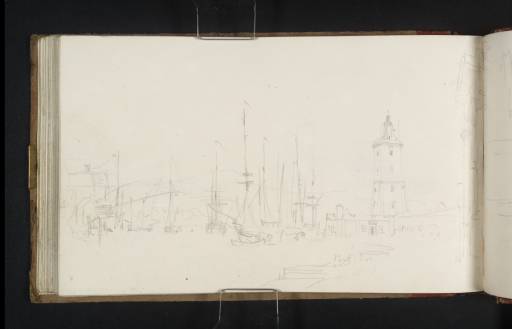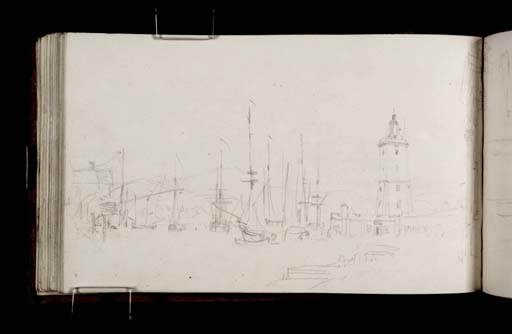Joseph Mallord William Turner Shipping Moored off the Pier and Lighthouse at Ancona, from the Arco Clementino 1819
Image 1 of 2
Joseph Mallord William Turner,
Shipping Moored off the Pier and Lighthouse at Ancona, from the Arco Clementino
1819
Joseph Mallord William Turner 1775–1851
Folio 69 Verso:
Shipping Moored off the Pier and Lighthouse at Ancona, from the Arco Clementino 1819
D14614
Turner Bequest CLXXVI 65a
Turner Bequest CLXXVI 65a
Pencil on white wove paper, 111 x 184 mm
Accepted by the nation as part of the Turner Bequest 1856
References
1909
A.J. Finberg, A Complete Inventory of the Drawings of the Turner Bequest, London 1909, vol.I, p.519, CLXXVI 65a, as ‘Port of Ancona’.
1984
Cecilia Powell, ‘Turner on Classic Ground: His Visits to Central and Southern Italy and Related Paintings and Drawings’, unpublished Ph.D thesis, Courtauld Institute of Art, University of London 1984, pp.92, 466 note 109.
1987
Cecilia Powell, Turner in the South: Rome, Naples, Florence, New Haven and London 1987, pp.25, 202 note 45.
1997
James Hamilton, Turner: A Life, London 1997, pp.198, 325 note 13.
Apart from a handful of earlier subjects drawn on random pages within the sequence (folio 70 recto opposite, possibly folio 82 verso, and folio 83 recto; D14615, D14640, D14641; Turner Bequest CLXXVI 66, 78a, 79) and at the very end, Turner devoted the remaining pages of this Venice to Ancona sketchbook (from here to folio 86 recto; Turner Bequest CLXXVI 82; D14614–D14647)1 to a thorough survey of the Adriatic port of Ancona, which he had approached along the coast from Rimini.
The Turner scholar C.F. Bell annotated Finberg’s 1909 Inventory entry for this initial page (‘Port of Ancona’): ‘The Dogana and Fanal’2 (i.e. lighthouse). The viewpoint is the Banchina beside the Baroque Arco Clementino, which is continued a little way across the gutter on folio 70 recto (D14615; Turner Bequest CLXXVI 66). To the west along the mole is the lighthouse (only the broad base of which now survives, supporting a modern coastguard station beyond cranes and railway lines), while beyond the forest of masts are hills on the far side of the bay, to the south-west.
Facing west over the sheltered and well-used bay, the Ancona’s numerous towers and domes lay between its cathedral on a headland to the north, overlooking the pier, and the extensive hilltop Cittadella to the south. The sweep of the seafront was punctuated by monumental Roman and Baroque arches and walls, while the pentagonal Lazzaretto quarantine complex lay just off the shore below the Cittadella. Turner surveyed them all from multiple viewpoints as he took in the inherent grandeur and drama of the setting, although he developed none of the subjects any further. Apart from the lighthouse, minor structures have come and gone and the port areas have been developed for modern shipping, but the key features remain as Turner recorded them.
Cecilia Powell has observed that he was ‘clearly excited’ by these combinations,3 appealing in particular to his ‘love of the sea and of harbours’, and would find comparable stimuli at Naples on Italy’s west coast later on this tour, 4 while James Hamilton has noted: ‘Turner’s detour to the Adriatic shows how eager he was to see Italy from all its angles, and not just the obvious sights. He was one of the few Englishmen of the period immediately after Waterloo to consider a journey to Ancona to be worthwhile.’5
Matthew Imms
March 2017
How to cite
Matthew Imms, ‘Shipping Moored off the Pier and Lighthouse at Ancona, from the Arco Clementino 1819 by Joseph Mallord William Turner’, catalogue entry, March 2017, in David Blayney Brown (ed.), J.M.W. Turner: Sketchbooks, Drawings and Watercolours, Tate Research Publication, July 2017, https://www


